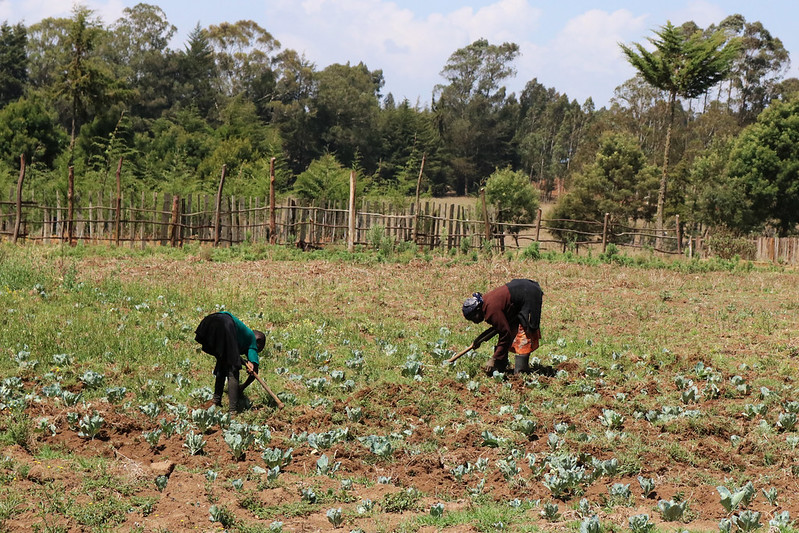Smallholder Farmers in Kenya and Their Challenges
 Prolonged drought, rising global temperatures and economic challenges have caused food insecurity to increase in Kenya. Food insecurity affects large urban cities like Nairobi and arid and semi-arid lands (ASAL) in the country’s northernmost region as impoverished Kenyans face rising food prices, making affordability hard for families in extreme poverty. Agriculture production makes up much of Kenya’s gross domestic product (GDP) and is essential to feeding domestic consumers. Large farms are an important part of the nation’s agriculture sector. However, smallholder farms produce more than 70% of the food used domestically and exported globally. Without efficient production by smallholder farms, Kenya’s protracted food insecurity will continue to take hold of the country. However, smallholder farmers in Kenya face several challenges.
Prolonged drought, rising global temperatures and economic challenges have caused food insecurity to increase in Kenya. Food insecurity affects large urban cities like Nairobi and arid and semi-arid lands (ASAL) in the country’s northernmost region as impoverished Kenyans face rising food prices, making affordability hard for families in extreme poverty. Agriculture production makes up much of Kenya’s gross domestic product (GDP) and is essential to feeding domestic consumers. Large farms are an important part of the nation’s agriculture sector. However, smallholder farms produce more than 70% of the food used domestically and exported globally. Without efficient production by smallholder farms, Kenya’s protracted food insecurity will continue to take hold of the country. However, smallholder farmers in Kenya face several challenges.
Lack of Access
Lack of access to various services and resources is one of the biggest problems for smallholder farmers and a main reason for stagnant economic growth. Small farms are usually located in rural areas, isolated from wholesale markets, forcing farmers to sell goods via brokers, leaving many needy farms vulnerable to fluctuating prices. Due to land grabbing by larger companies, access to fertile land is limited, making the jobs of small farmers much harder.
Without access to better markets, smallholder farmers in Kenya will continue to fall victim to multinational corporations selling products at low prices to rack in massive profits. Through methods like land grabbing and enacting repressive policies, small farmers have become dependent on larger companies for agricultural inputs needed to produce fresh crops.
Due to traditional lending institutional practices, credit remains one of the most difficult resources for smallholder farmers to access. Demand for high collateral, high interest rates and a shortage of credit lending educational services make it hard for small farm owners to gain credit.
A Need for Quality Infrastructure
Mobile communication devices are becoming essential tools for smallholder farmers, making accessing and exchanging agricultural information easier. Challenges in infrastructure have been exposed due to rural farmers’ limitations when using mobile devices. The availability of reliable power has become a concern among multiple rural counties, as well as internet connectivity issues and high prices for data packages.
Water scarcity has also become a problem that affects not only smallholder farmers but small-scale irrigation systems as well. ASAL areas depend on artificial water applications for farming. However, growing urbanization, rising water consumption and various water uses have led to dwindling water distribution throughout the nation, greatly affecting farms in rural areas.
Multinational Competition
Government-enacted laws and policies focus more on controlling large money producers, leaving small farmers at the mercy of Chief Executive Officers (CEOs) looking to make a profit. To develop, promote and regulate a modern and competitive seed industry, the Kenyan government gave larger agricultural corporations control over processes like seed certification, making it harder for impoverished farmers to afford certification and obtain seeds for planting.
Seed sharing was a system of exchange that helped domestic farmers for generations. However, as a way to keep producing money, the government criminalized seed sharing, affecting the livelihoods of smallholder farmers who depend on the cost-effective method that many would consider a timeless tradition.
Outside Assistance
Nongovernment organizations like Nuru are working to provide education and assistance to agribusinesses in low-income communities facing food insecurity. Through the introduction of various cultivation methods, farmers are better equipped with the resources to self-sustain and improve food productivity in the area. Since 2008, Nuru has reached more than 320,000 people in five African countries, including Kenya. Nuru farmers in Kenya have seen more than 200% of their crop yields from baseline.
Additionally, the Grameen Foundation, a nonprofit dedicated to ending global hunger, has launched a five-farmer-to-farmer program in Kenya that will connect smallholder farmers to financial volunteers whose focus will be to train farmers in business planning, financial management and financial literacy and establish alternative credit scoring methods. Farmers will receive better chances at obtaining loans, making affording seeds, equipment and other resources easier.
Final Remark
Smallholder farmers in Kenya are the key to unlocking the nation’s full agricultural potential. They make up almost 70% of agricultural production without full government assistance or access to credit markets. As a way to not only put an end to food shortages nationwide, investments in smallholder farmers need to increase to provide economic improvements across Kenya.
– Immanuel Wiggins
Immanuel is based in Jackson, USA and focuses on Global Health for The Borgen Project.
Photo: Flickr
